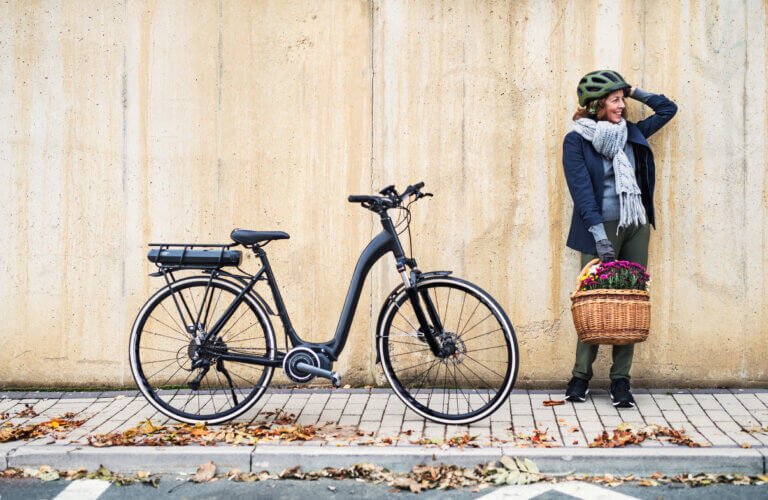Everything you need to know about electric bicycles, rebates, and quite frankly, having fun.

Electric bicycles. E-bikes. Pedal-assist motors. No matter what you call it, e-bicycles are here to stay and there are plenty of ways to find discounts if you’re looking to buy, and free money if you already have.
First, A Little History About Electric Bikes
We know not everyone’s a history buff, so let’s just cover the fun facts to get started.
Electric Bicycle Fun Fact #1
E-bikes have been around longer than you think. The first patents in the United States for electric bicycle motors date back to the late 1800s.
Electric Bicycle Fun Fact #2
One of the earliest e-bike models was born in France. It had hand controls and no pedals.
Electric Bicycle Fun Fact #3
E-bicycles started taking off in Europe in the 1930s with the popular 1932 Phillips Simplex Electric Bike.
Electric Bicycle Fun Fact #4
Japan hopped on the e-bike train in the 1970s and 1980s when Panasonic, Yamaha, and Sanyo started producing their own models.
Electric Bicycle Fun Fact #5
To encourage sustainable transportation, governments (and bike-friendly organizations) began offering financial incentives to electric bike owners. Such incentives include tax credits, energy rebates, and subsidies.
What “Counts” As An Electric Bicycle?
Now that we know the origins of our beloved e-bikes, let’s go over how they’re different from other similar rides. That’ll come in handy when it’s time to insure your e-bike or determine whether you’re eligible for a government rebate (which we’ll get to next).
E-Bicycles Vs. Traditional Bicycles
Electric bicycles are nearly the same as traditional bicycles. Cyclists can ride, do front flips, and even make it to work on time with either option. However, e-bikes have an electric motor that can be used to power the bicycle entirely or used as a pedal-assist.
E-cyclists opt for the electric option as a solution for avoiding morning traffic, arriving to work on time and less sweaty, and a cost-effective alternative for owning a vehicle.
Plus, we think they’re kinda fun.
E-Bicycles Vs. Electric Motorcycles
The difference between an electric bicycle and an electric motorcycle is going to come down to a few factors. First and foremost, an electric bicycle offers pedals or a way to operate the vehicle without using a motor or battery.
Secondly, it’s up to your local government (city and/or state) to define how fast your electric bike can go before being considered a motorcycle. This will usually be determined in miles per hour, horsepower (HP), and/or wattage.
Additionally, electric motorcycles require riders to be licensed and oftentimes insured, and they can’t be ridden on bike paths or other forms of bicycle infrastructure. E-bikes don’t require a license and can be taken on bicycle paths.
E-Bicycles Vs. Predator Vs. Alien
This is probably the most controversial topic amongst e-bike riders and for good reason. Who wins in an epic battle of wits and strength?!
We’re putting our money on e-bicycles, but honestly, we’d just like this debate settled once and for all.
Rebates And Other Financial Incentives For E-Bikes
E-bicycles can be expensive, but they’re also beneficial for larger economies. Cities, states, and energy corporations alike offer rebates, tax breaks, and other financial incentives for the purchase or manufacturing of electric bicycles.
Simply put, a rebate is free money from a company or organization! But there’s a little more to that. Cities, local governments, and even energy companies offer rebates to cyclists who own and operate an electric bicycle to encourage things like:
- Fewer cars on the road
- Cleaner energy consumption
- Increased sales and job creation
- Less pollution
- Raising public awareness of electric vehicle or transportation alternatives
E-bicycle rebates are oftentimes funded publicly, meaning the money comes from the government (tax dollars). Because of the nature of budgets, rebates aren’t usually endless or bottomless – there’s a set number of rebates.
Pro Tip: Publicly-funded rebates are also known as partial purchase subsidies
This is why, typically, organizations offering rebates for e-cyclists require an application. Cyclists provide basic information about themselves and their e-bicycle in exchange for a rebate (i.e. cash) if they’re approved. This information usually includes spec sheets, receipts, or other proof of purchase documentation.
Once all of the rebates are claimed, e-cyclists can either find another rebate to apply for, wait to see if the program is funded again in the future, or search for state and federal tax credits.
How Do I Get That Sweet, Sweet Government E-Bike Money?
Looks like someone’s interested in that cold, hard government cash. And we don’t blame you! We’re all about discounts and affordable solutions ourselves. So what can e-cyclists do to get their hands on some rebates and tax breaks?
Know that not all rebates are limited!
Electric bicyclists can do a little digging in their community to find organizations and utilities like Austin Energy that have an open, ongoing rebate program. Roll up your sleeves and search online for local utility companies to get started. Plenty of state-level rebates can earn you a couple of hundred bucks just for doin’ your e-bike thing.
Even though some rebates are open-ended, there might be restrictions including:
- How fast your electric bicycle is
- E-bike brands
- When you purchased your electric bicycle
- Eligibility extended only to utility customers

Electric bicyclists can apply for federal or state tax breaks!
That’s right, the U.S. and some states offer tax breaks for people who purchase an electric bicycle. The same rebate restrictions as listed above may apply to these tax incentives as well, but it’s certainly worth exploring to find yourself a couple hundred, or even a couple thousand, dollars richer.
Search for vendor-funded discounts!
Sometimes vendors or manufacturers work with cities or states to fund discount programs that incentivize private citizens to purchase electric bicycles and vehicles. These programs are for individuals looking to make a purchase, as opposed to rebates that retroactively benefit those who have already bought an e-bike.
Keep an eye for these online, especially on social media. Companies will offer discounts for the first, for example, a hundred electric bikes sold – so they go fast!
Check out government-sponsored loans!
Low-interest loans are available for individuals interested in an electric alternative. While these programs aren’t giving away “free money” – they are an accessible, affordable solution for people who want an electric bike, but can’t necessarily afford one immediately.
Ask your employer about employer-sponsored electric vehicle incentive programs!
This might be a long shot, but you never know. Some organizations offer electric bicycle and vehicle sponsorship programs – and you might be able to talk your company into doing the same if they don’t already.
Basically, organizations with non-profit tax statuses can apply for the same or similar rebates mentioned earlier in this article. These employers can then pass down the benefits by offering electric vehicles to employees as a means of transportation. Organizations that don’t have such tax benefits may offer these types of programs simply as a form of employee appreciation or general benefit.
